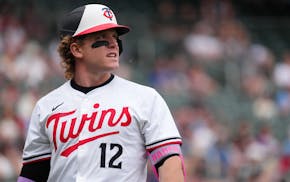Much like the acute wail of the common loon that resonates deeply with many Minnesotans and signals another summer, state wildlife managers have made the annual call out for conservation-minded volunteers to help watch for them.
The effort is one of the ongoing projects focused on loons and their well-being within the Nongame Wildlife Program of the Department of Natural Resources. And it's a sizable job: Specialists who coordinate the Minnesota Loon Monitoring Program need volunteers to focus on six regions, each with 100 lakes, in central and northern Minnesota.
The regions are targets because it's common ground for returning loons, a landscape full of large, clear lakes with room for flight and habitat to breed and support young.
The monitors' work – counting adults and chicks they see daily over a 10-day window in early July — builds on a knowledge base and conservation effort that began in 1994.
What's known is the population of loons (about 12,000 breeding adults) is stable and remains the highest number of any state in the lower 48.
What also is known is the species is, like so many others in the avian community, vulnerable to disease and environmental threats.
Just this week, lab results on two dead loons (one found near Phalen Lake in St. Paul, the other in Chisago County) showed the presence of the highly pathogenic avian flu that has killed countless waterfowl and some raptors that have eaten them, according to Nongame Wildlife Program spokeswoman Lori Naumann.
There are standing challenges, too. Among them are the impact of land development on the loons' shoreline nesting habitat, and lead poisoning from consuming fishing tackle mistaken for food.
Monitors focus on waters in the aforementioned six regions: Kandiyohi, Otter Tail, Becker, Aitkin/Crow Wing, Itasca, and Cook/Lake, comprising eight counties. The Nongame Wildlife Program has a searchable web page on the DNR website where potential volunteers can view the "available" lakes to watch. Program coordinator Krista Larson, a Nongame Wildlife biologist, said currently volunteers are needed for 155 lakes. Monitoring a small lake can run up to an hour; double that on a larger lake. Access varies from lake to lake. Some vantage points are from public roadways and boat accesses. Others are from trails or the use of canoes and kayaks from private property.
Larson said the different regions have, for example, different levels of public vs. private land, densities of human population and levels of development.
"By this type of design, if we notice a decline in loon presence, loon density, or loon reproductive success, it may help us understand what factors are driving those declines," she said.
The Nongame Wildlife Program also oversees a related effort, the Volunteer LoonWatcher Survey, with more longevity. The survey, in its 42nd year, relies on volunteers who live on lakes (or regularly visit) across the state and report from their watch during the active season from May through the end of August. Some volunteers watch more than one lake and have contributed for decades.
LoonWatcher Survey coordinator and biologist Andrew Herberg said volunteers' reports are vital to building on the data set about the reproductive ecology of loons. Participants count the birds but also keep a phenological accounting of, for example, their arrival, nesting behavior and the status of chicks.
In the most recent summary from 2020, 124 LoonWatcher volunteers watched 160 lakes across 26 counties and filed reports on loon numbers, active nests and their young. They observed 921 adult loons and saw 251 loon chicks hatch, 186 of which fledged. As many as 162 lakes are part of LoonWatcher so far this year.
Both programs rely on "hardcore, established" volunteers who re-up annually, said Naumann, but the need for new volunteers is inherent. The regions are vast, and people move or move on.
"So it's always a challenge for certain areas," she added.
Herberg said while the state's loon population is overall "good," threats loom that make the data collected from LoonWatcher and the monitoring program more valuable for tracking the state bird's health.
"It's such a charismatic and iconic species," he said. "It's understandable that people want to get involved."

Former Gophers football standouts embrace being basketball dads

Reusse: Once-formidable Twins starting rotation vulnerable without López

Twins lose second in a row to Blue Jays as bullpen falters late
What is the 'House settlement,' and what does it mean for the Gophers and NCAA?

